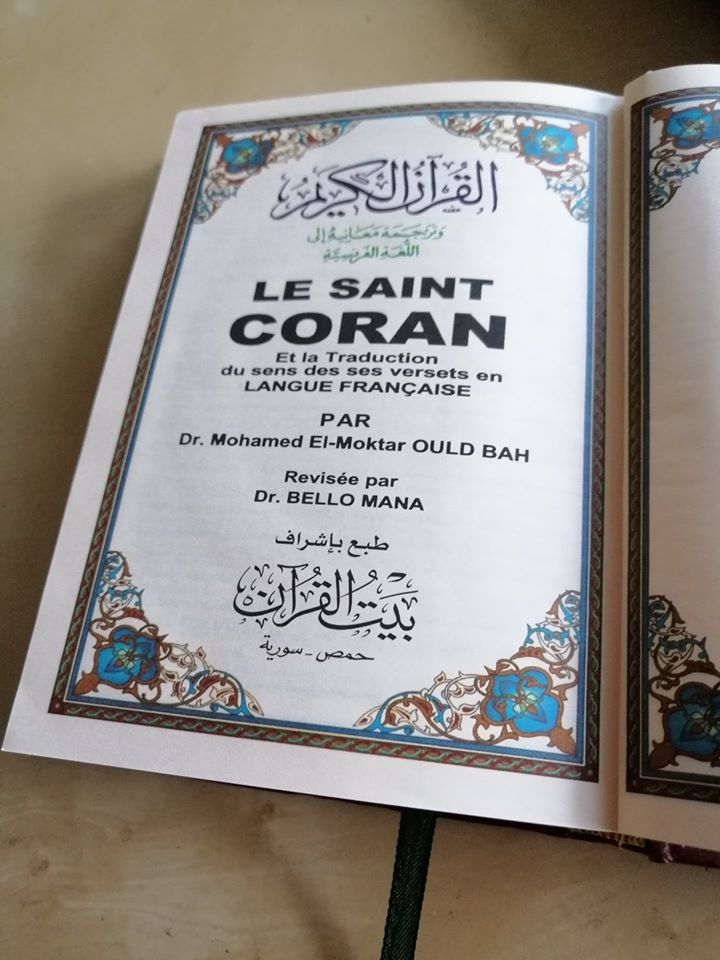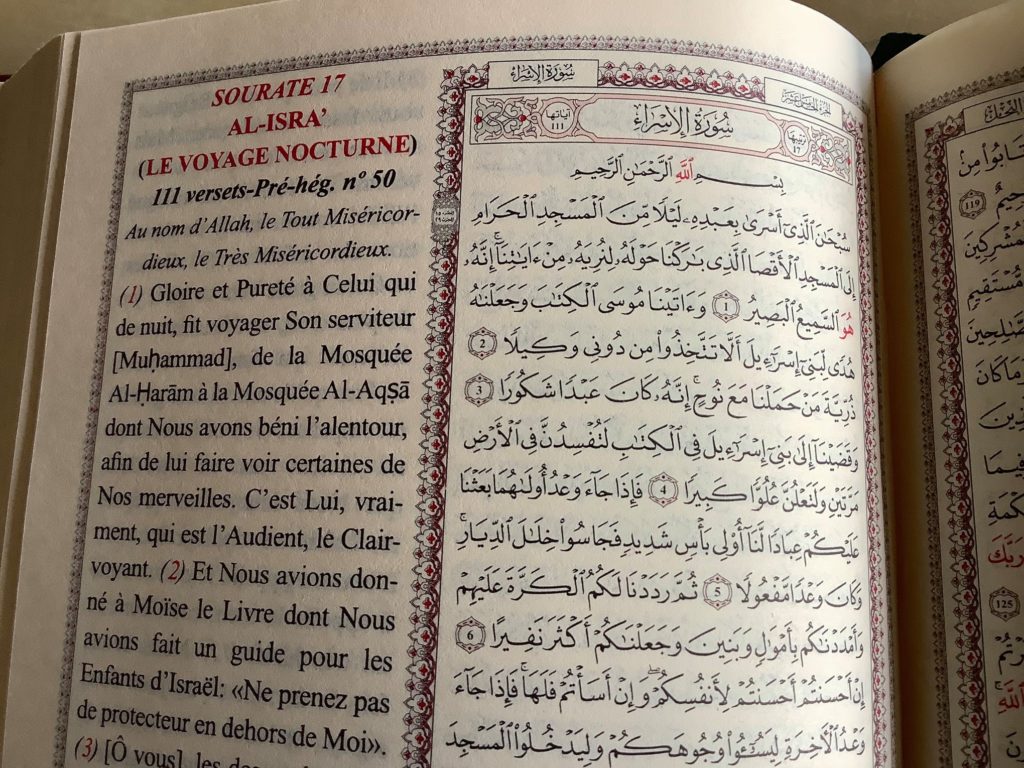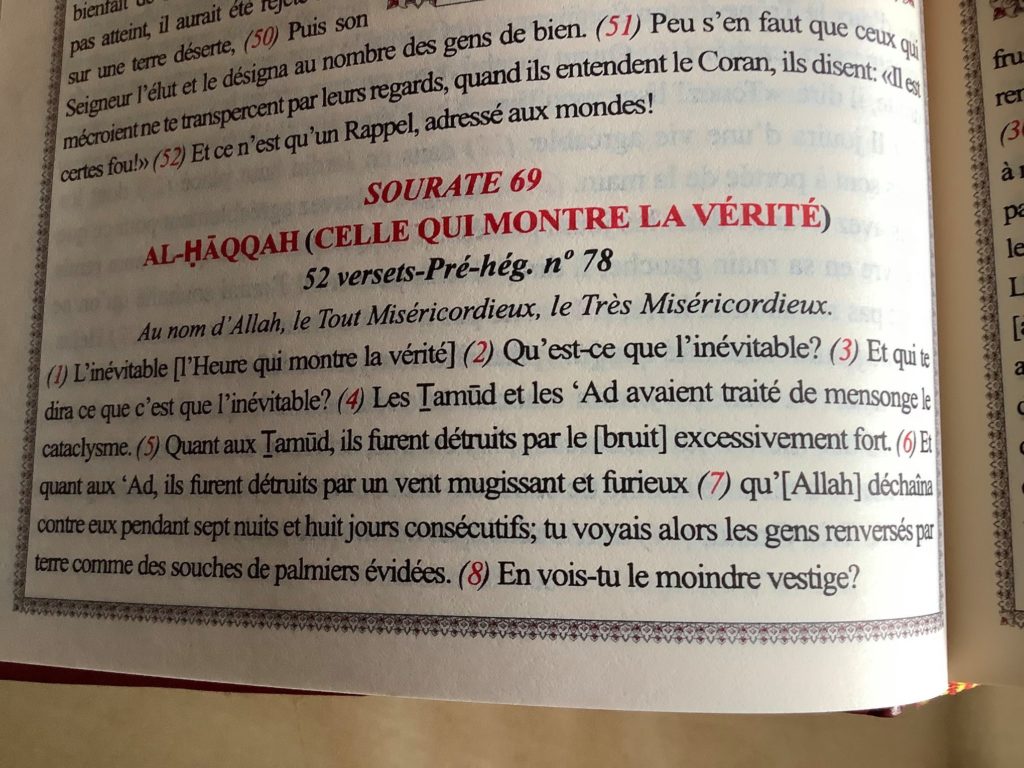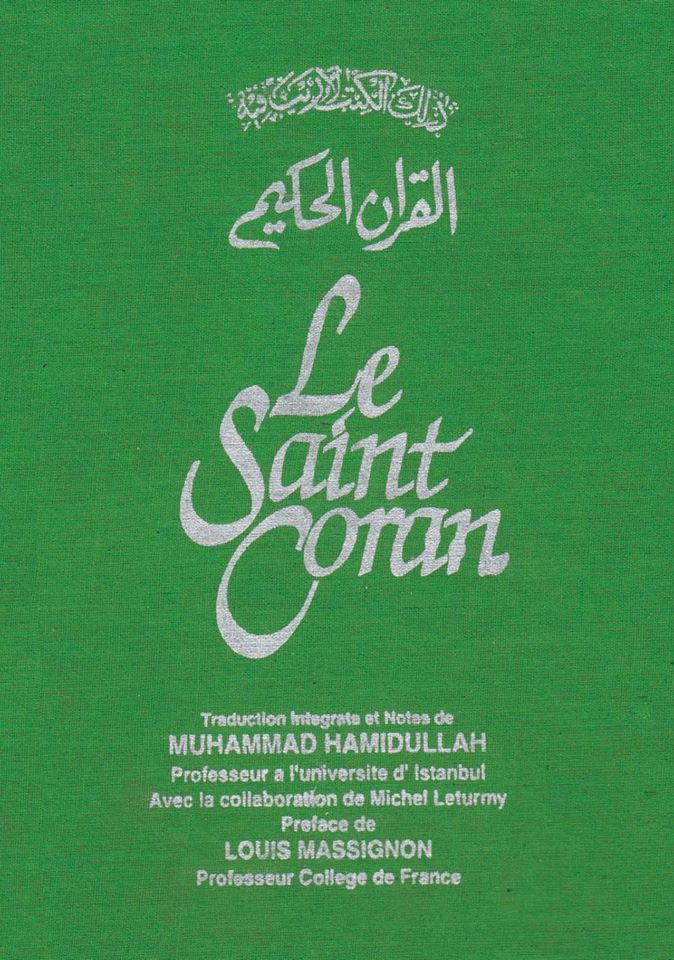This book, which I purchased in a bookstore in Tunis, was published in Homs, Syria, in 2011 and claims to contain a French Qur’an translation produced by the Mauritanian scholar Mohamed El-Moktar Ould Bah (b. 1924) for the King Fahd Complex in Medina – evidence of the longstanding presence and importance of Mauritanian scholars in the Hijaz and Saudi Arabia. As such, the book seems to be a case in point for the global dimension of the field of Qur’an translation.
At second glance, it is also a case in point for its complexities because the translation it contains is not at all, as the title page and the foreword claim, the one by Mohamed El-Moktar Ould Bah, which is the work that is currently sponsored and distributed by the King Fahd Complex. Rather, it is an edition of the translation by Muhammad Hamidullah (1908–2002), a native of Hyderabad who emigrated to France. His work, which was first published in 1959 and featured a foreword by the Orientalist Louis Massignon, was not the first French Qur’an translation by a Muslim but the first that gained widespread popularity. Therefore, the Muslim World League commissioned the King Fahd Complex to edit and publish it. This happened at a time when the King Fahd Complex only just started printing Qur’an translations and usually chose to edit and distribute popular existing works. The editors removed most of the copious notes, changed the introductions to surahs and undertook many linguistic and exegetical revisions. Hamidullah was reportedly not happy with the result. Nevertheless, the edited version was published in 1990, and a further edition in 2000. The latter one is now widely available on the internet, in apps and even in this Syrian edition which the publisher mistakenly identified as the Complex’s own, more recent translation by Mohamed El-Moktar Ould Bah.
This is symptomatic of the widespread disregard for intellectual ownership of Qur’an translations and also for sloppy publishing practices. The typesetters were not equipped to deal with the transliteration of Arabic, resulting in changes in typeface throughout the text. They also discarded the footnotes entirely. The use of Western numerals in the Arabic text of the Qur’an is interesting, pointing to a Maghrebi target audience – or, again, unprofessional typesetting.
An interesting feature of this recension of Hamidullah’s translation is the emphasis on the chronology of surahs, which is based on the 1924 Cairo edition of the Qur’an. Each surah is given a rank within the order of revelation. This suggests a degree of unanimity and precision with regard to chronology that does not so much reflect the scholarship in Qur’anic studies as it reflects a process of standardization that has occurred since the introduction of print in the Muslim world. This is also apparent from the fact that the editors adapt Hamidullah’s system of numbering verses, where the Basmala is not counted as a verse in the Fatiha (Q. 1), to the system that is most common today.
While the editors often follow Hamidullah’s text closely, they improved and simplified it stylistically in some places. They also took care to “Islamicize” Hamidullah’s language, for example by changing “Dieu” to “Allah”. Occasionally they insert information from the exegetical tradition into the text. For instance, they identify the woman who tried to seduce Joseph as Zulaikha although she is unnamed in the Qur’an. Sometimes they completely deviate from Hamidullah’s interpretation, for example by rendering “By the fig and the olive!” (“Par la figue et par l’olive!”) in Q. 95:1 as “By the fig tree and the olive tree!” (“Par le figuier et l’olivier!”) One reason for this might have been that Hamidullah, in his notes, followed a modernist tradition started in the journal al-Manar in the early 20th century by drawing a link between the fig as mentioned in Q. 95:1 and the Buddha. This opened up the possibility of expanding the scope of revealed religions beyond Judaism, Christianity, and Islam.
Conversely, the editors of Hamidullah’s translation clearly express an exclusivist understanding of religion, sometimes by semantic choices and sometimes through insertions. In their translation of Q 3:85, Hamidullah’s “And whosoever desires a religion other than Submission, it will not be accepted from him” (“Et quiconque désire une religion autre que la Soumission, de celui-là ne sera point reçu”) becomes “And whosoever desires a religion other than Islam” (“Et quiconque désire une religion autre que l’Islam, ne sera point agréé”) after revision. Unlike Hamidullah, they specify the belief in Muhammad and the Qur’an as a prerequisite for entering Paradise in their rendering of Q. 2:62. Hamidullah translated the verse as “Yes, those who have believed, those who have embraced Judaism, the Nazareans, and the Sabeans, whosoever from among them has believed in God and in Last Judgment and has performed good deeds, for those, their compensation is from their Lord. Upon them, no fear; and they will never be afflicted” (“Oui, ceux qui ont cru et ceux qui se sont judaïsés, et les Nazaréens et les Sabéens, quiconque a cru en Dieu et au Jour dernier et fait œuvre bonne, pour ceux-là, leur récompense et auprès de leur Seigneur. Sur eux, nulle crainte: et point ne seront affligés”). In the Complex’s revised version, a footnote clarifies that this only pertains to Muslims. The Syrian edition, which does not have footnotes, adds an explanation in brackets: “… whosoever from among them has believed in Allah (in the form of perfect belief, namely by professing faith in Muhammad PBUH and in that which he has brought)…” (“… quiconque d’entre eux a cru en Allah [de la parfaite croyance, c’est-à-dire ajouter foi à Mouhammad saw et à ce qu’il a apporté…”). This precludes any possibility for Jews, Christians and Sabeans to enter Paradise unless they embrace Islam, which suggests that theological streamlining was a major driving force behind this edition.
The complex publication history of this book demonstrates the hybrid nature of many contemporary Qur’an translations. They are the result of editing and standardization processes that have so far been insufficiently understood. They are also exegetical works in their own right, using semantic and syntactic choices as well as insertions and additions to deliver a concise interpretation that sometimes bears a certain similarity to paraphrastic Qur’anic commentaries such as Tafsir al-Jalalayn. The interpretive choices that are discernible in such translations root them firmly in the Islamic exegetical tradition.
Johanna Pink





